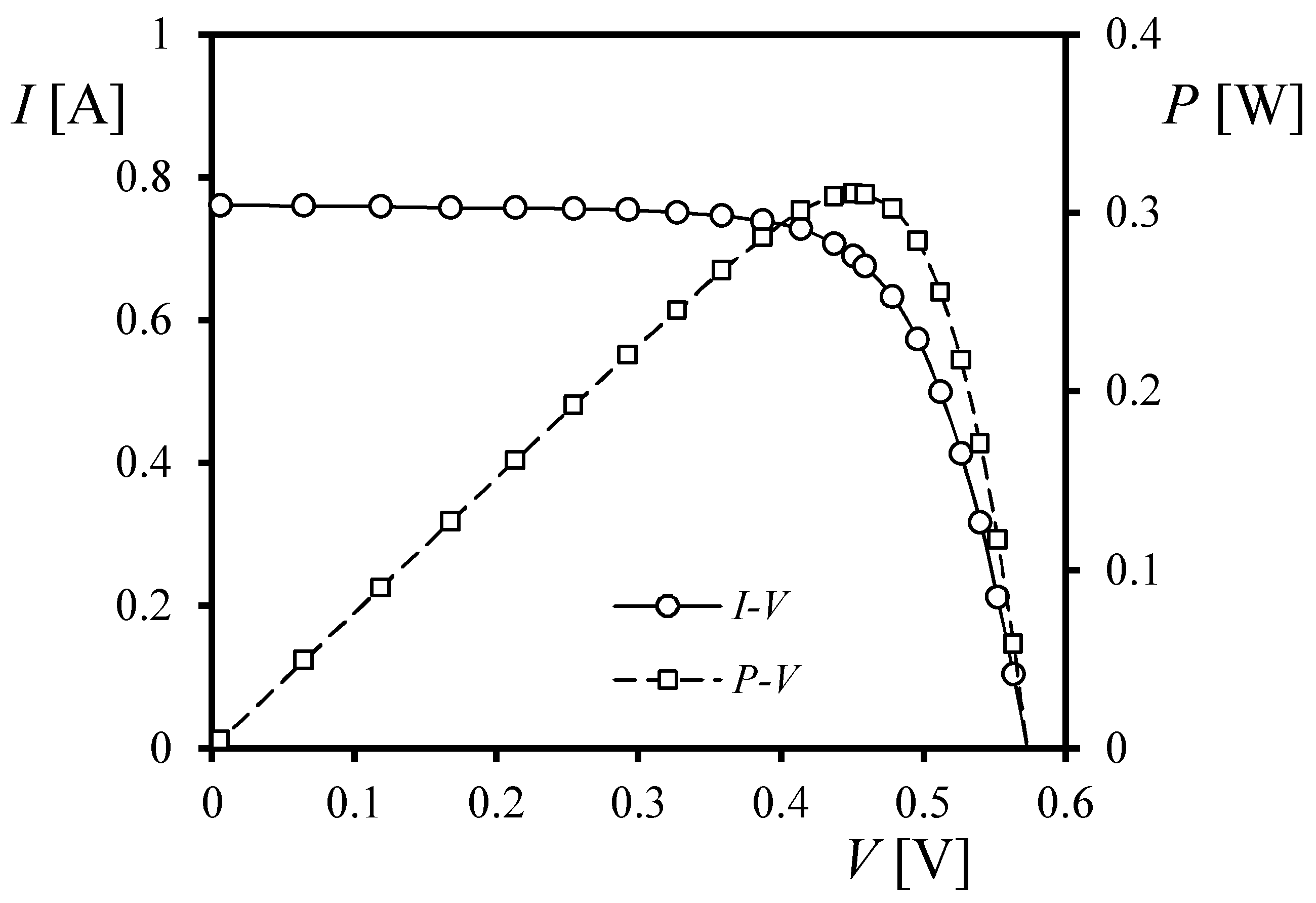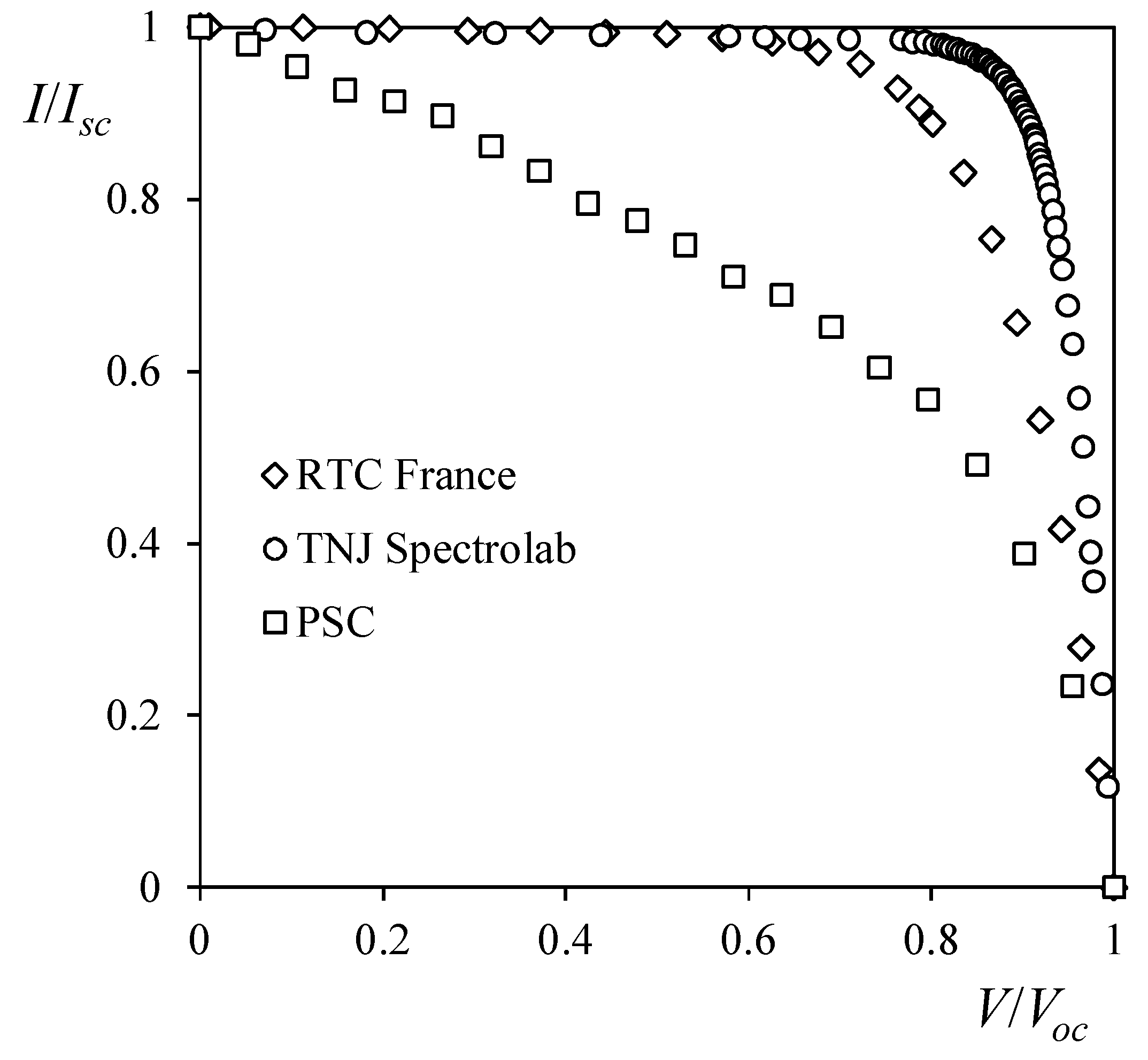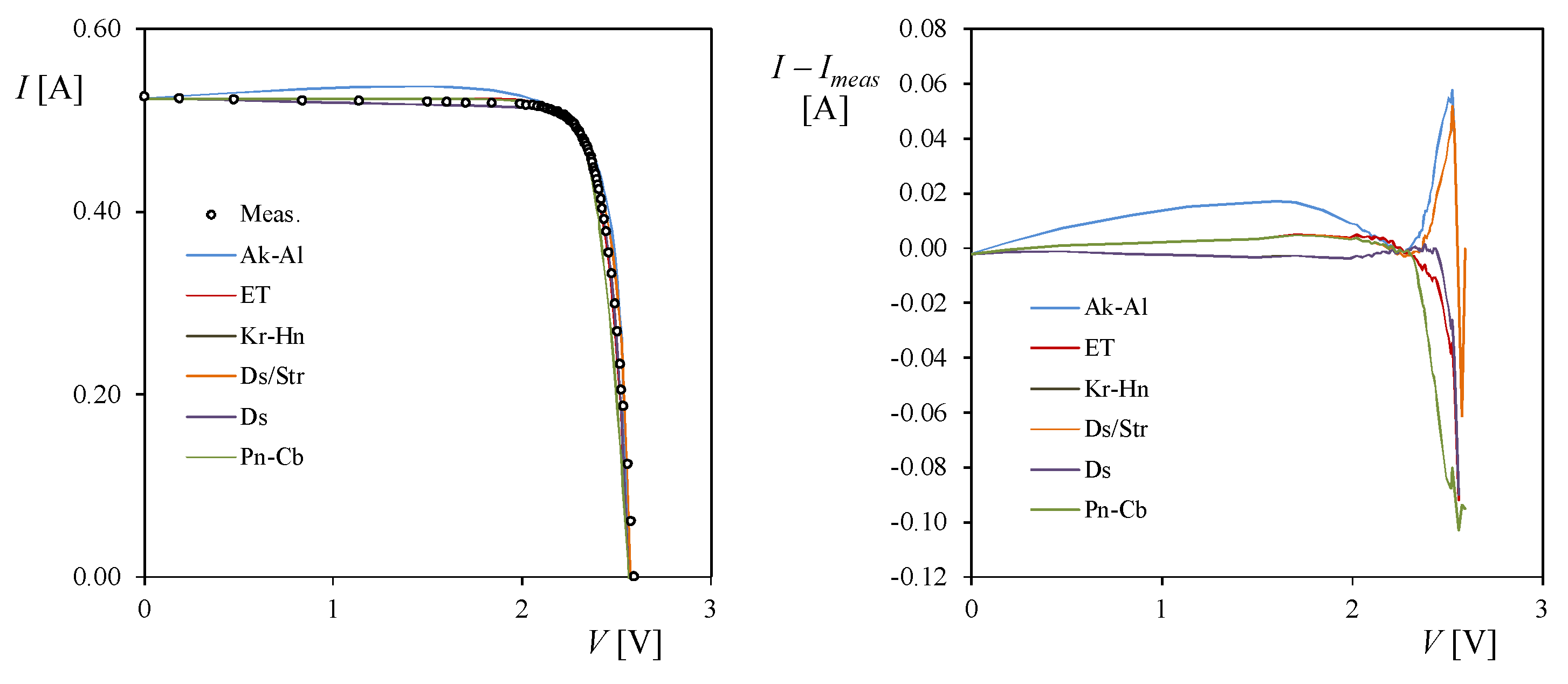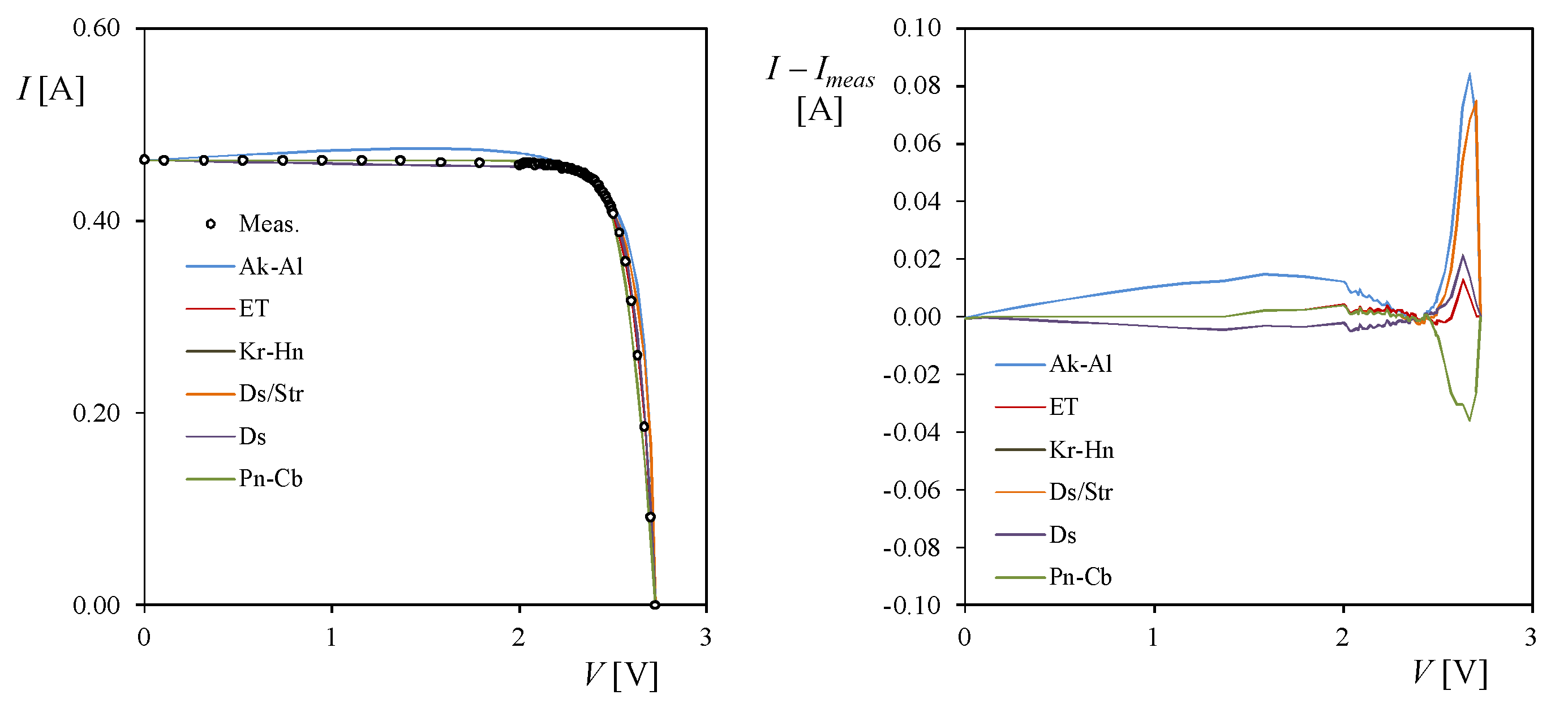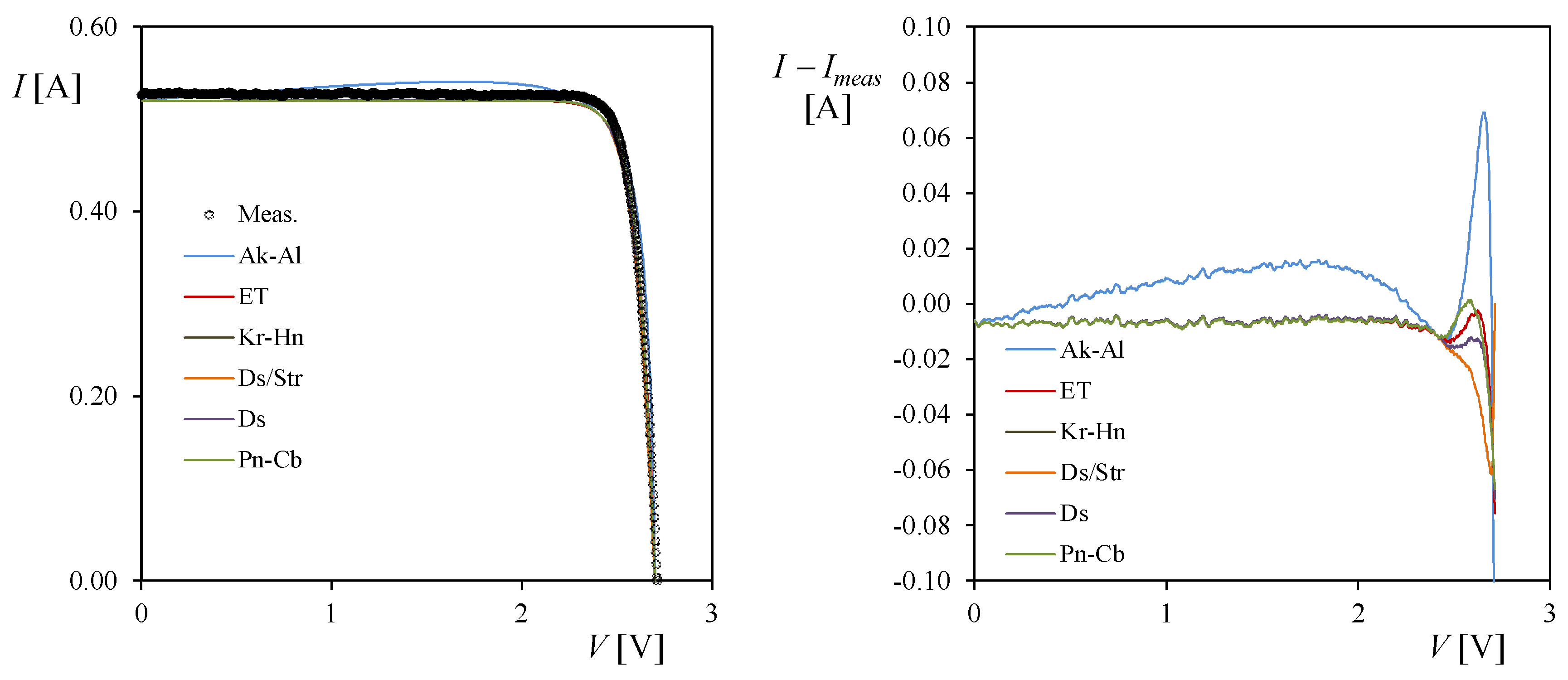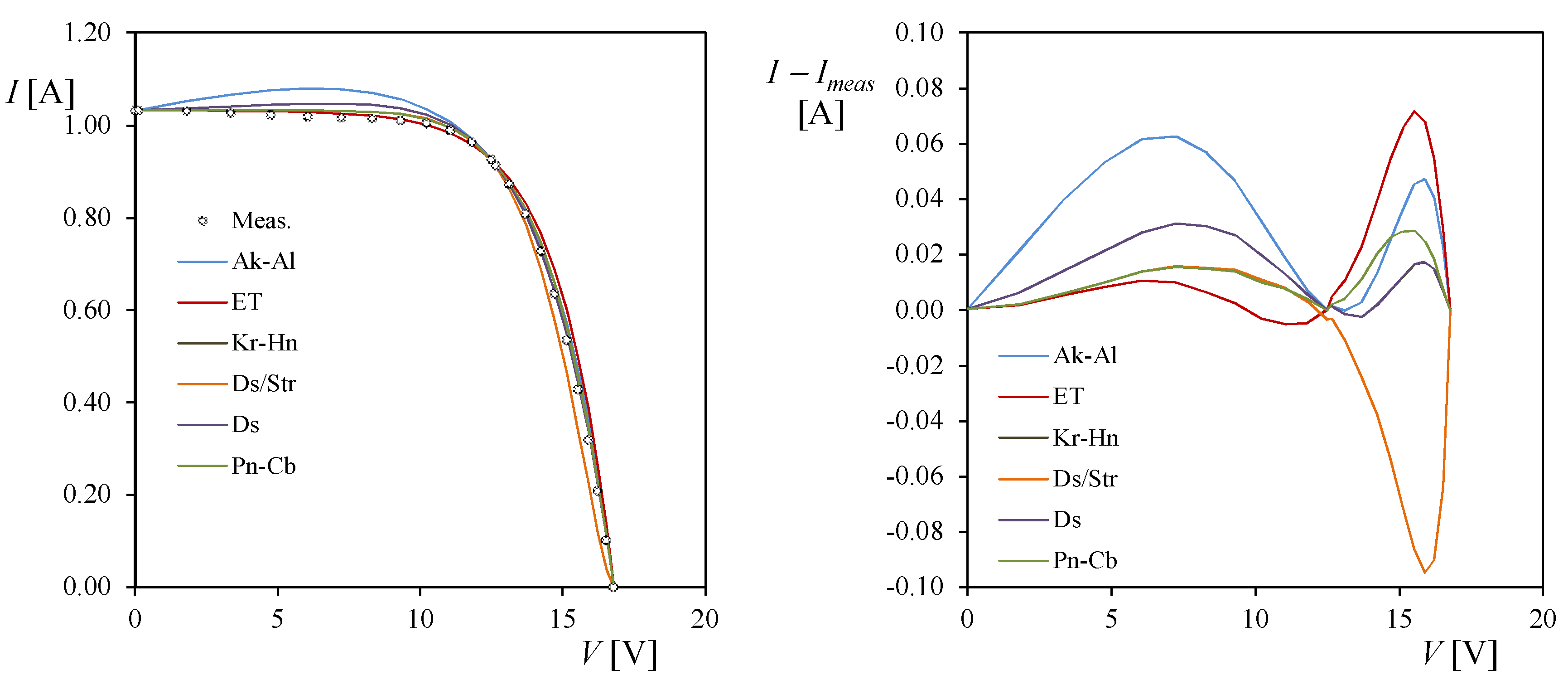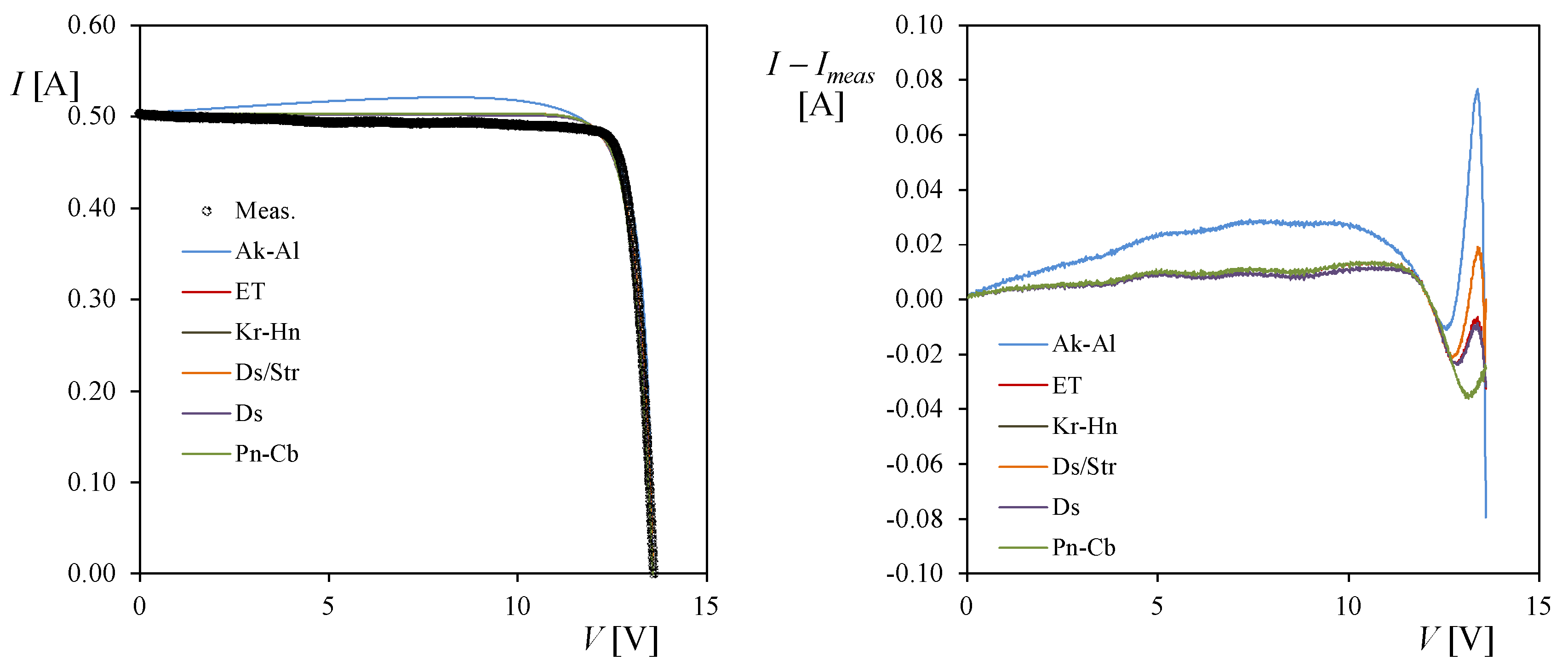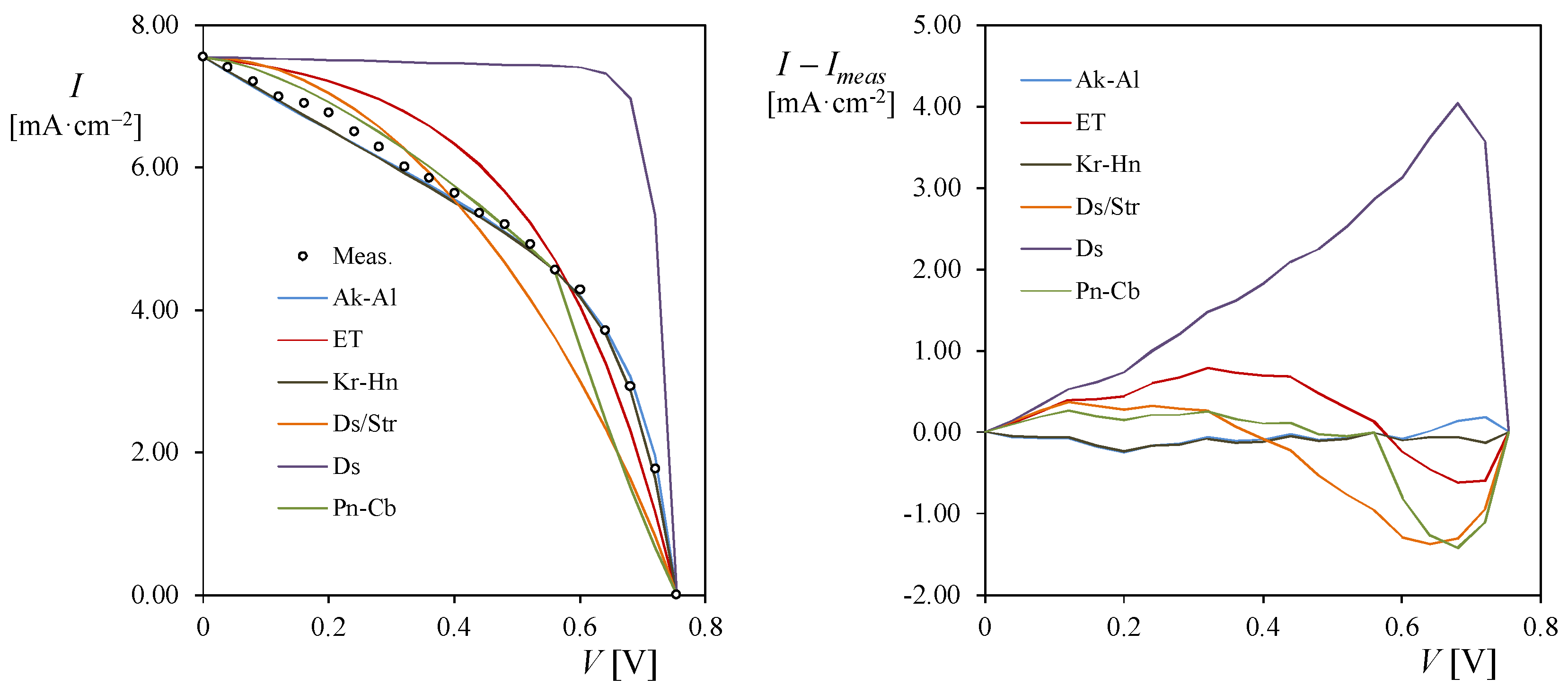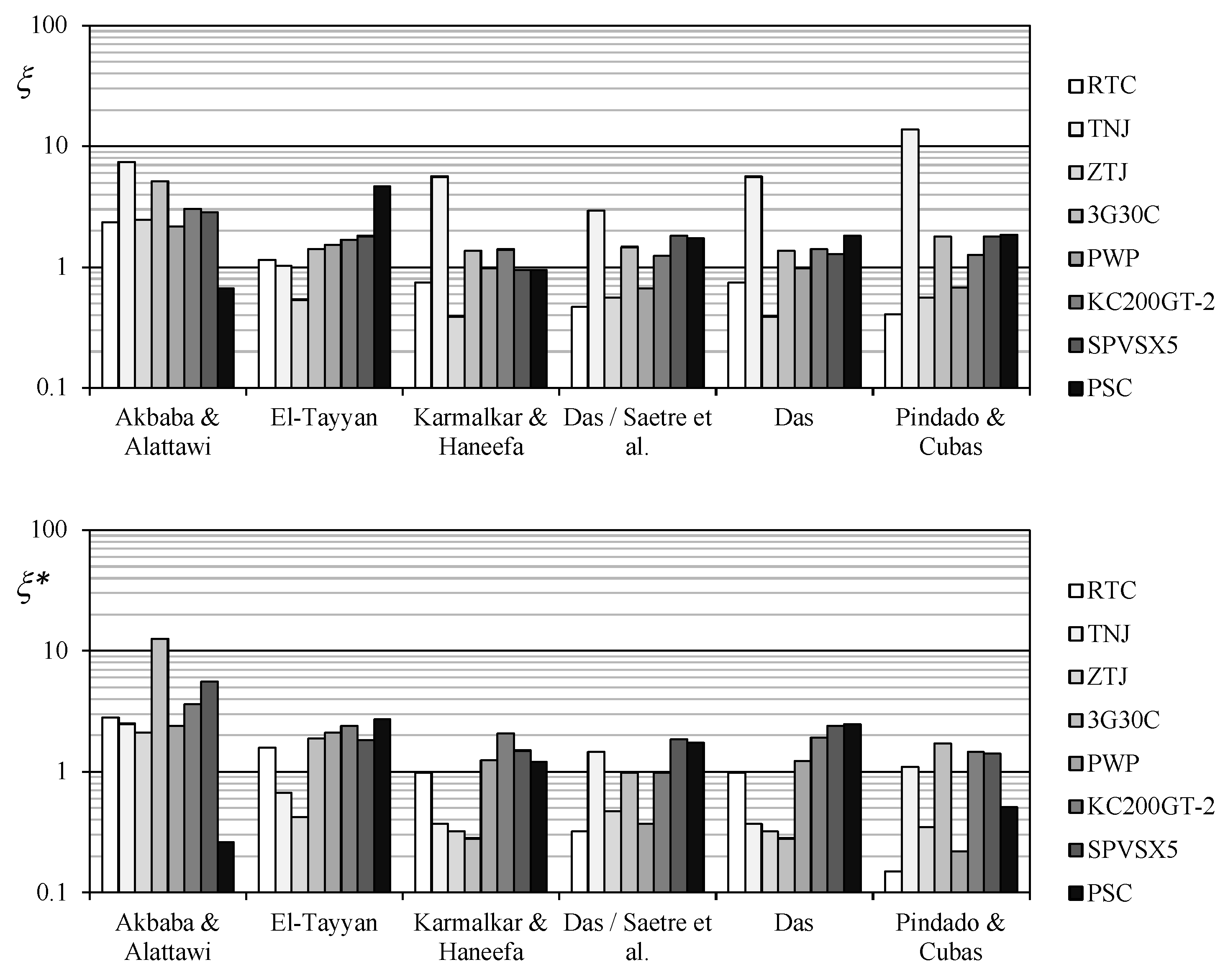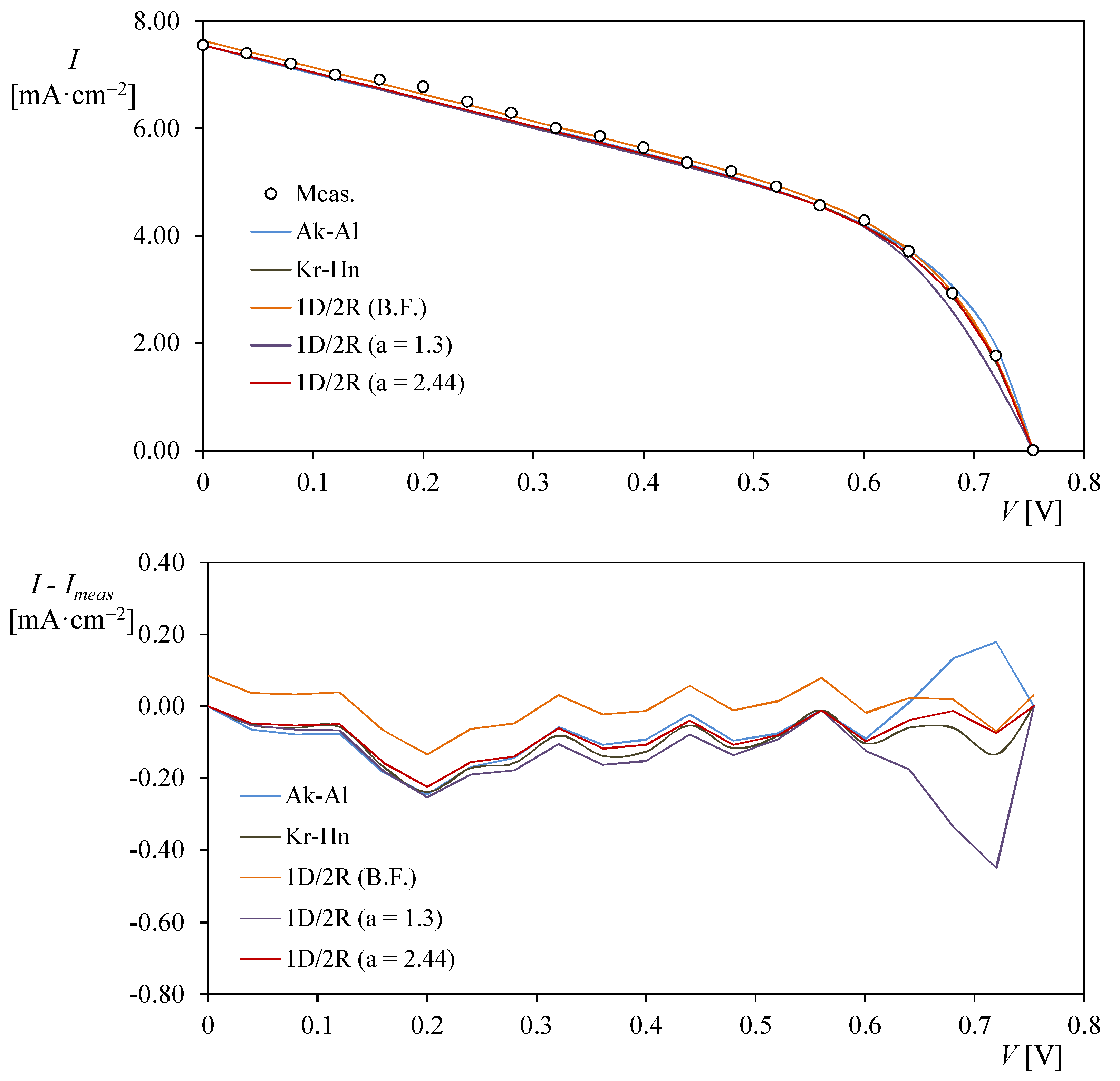1. Introduction
The most common mathematical expression for simulating the behavior of photovoltaic devices (solar cells/panels) is derived from the 1-diode/2-resistor equivalent circuit model (see
Figure 1):
This equation relates the output current of the photovoltaic device,
I, to the output voltage,
V. This relationship is generally called the
I–
V curve of the solar cell/panel (see
Figure 2), and defines the behavior of the photovoltaic device at a constant temperature and specific irradiance level. The equivalent circuit is comprised of a source that supplies the photocurrent,
Ipv, a diode allowing
ID1 current through it, and the series and shunt resistors
Rs and
Rsh. As indicated in the above mathematical expression, the diode is characterized by the saturation current,
I0, the thermal voltage,
VT, (defined as a function of the temperature, the charge of the electron, and the Boltzmann constant; see [
1]), the ideality factor of the diode,
a, and the number of series-connected cells in the photovoltaic device,
n.
The above mathematical expression is, in fact, a simplified form of a more complex one involving two diodes connected in parallel rather than one:
In the past, this 2-diode/2-resistor equation was suggested for solar cell modeling where all terms contain physical meaning [
1]. Obviously, with the simplification to the 1-diode/2-resistor equation applied to solar panels comprised of several connected cells (or based on more evolved technologies such as multi-junction cells), the terms of Equation (1) have lost the direct modeling of the physical effects involved in the solar energy generation process. Nevertheless, that equation still retains physical meaning.
The parameter extraction process required to work with Equation (1) (i.e., to establish the correct values of parameters
Ipv,
I0,
a,
Rs, and
Rsh) is usually a challenging process, not an immediate task. Many procedures and techniques have been developed to perform this extraction, see for example the works by Cotfas et al. [
3], Tossa et al. [
4], Ortiz-Conde et al. [
5], Jena & Ramana [
6], Chin et al. [
7], Humada et al. [
8], Ibrahim & Anani [
9], and Abbassi et al. [
10]. In addition, a number of calculations must be performed to work with Equation (1), as it is an implicit mathematical expression. In order to facilitate technical work with photovoltaic devices, explicit mathematical expressions have been proposed to obtain output current
I directly, without using any algorithm, as a function of output voltage
V. Obviously, these expressions have the following form:
where
a1,
a2,
a3… are the parameters to be adjusted.
One might wonder why it is necessary to develop such immediate expressions when it is not difficult to accurately solve implicit equations by simply using commercial math software, such as MATLAB
®. On the one hand, not all professionals in the solar energy sector can spare the resources (cost, training) to use such software. On the other, even skilled scientists/engineers need to find quick solutions in the predesign stages of projects involving photovoltaic devices. In these cases, the use of an appropriate explicit expression might be the best option. This need was detected while programming the power subsystem module at ESA’s Concurrent Design Facility (CDF) for the predesign of space missions at
Instituto Universitario de Microgravedad “Ignacio Da Riva” (IDR/UPM), apart from other needs arising from academic and research work on space power systems at this institution [
11,
12,
13]. Additionally, machine learning has become one of the most promising methodologies for performing performance prediction [
14,
15] and fault diagnosis [
16,
17,
18,
19] for solar energy systems. These methods normally include rather complicated 1-diode/2-resistor or 2-diode/2-resistor equivalent circuit parameter extraction techniques [
20,
21], such as genetic algorithms and particle swarm optimization [
22,
23,
24]. The use of the explicit models included in this article might be also possible in machine learning.
It would be fair to cite some other lines of research, apart from explicit equations, developed to facilitate work with photovoltaic
I–
V curves, or at least to reduce the difficulties of parameter extraction when working with the 1-diode/2-resistor model. First, the work of Toledo et al. [
25,
26,
27,
28] must be highlighted, as these researchers have developed different mathematical and iterative ways of performing such parameter extraction based on a reduced number of points from the
I–
V curve. Second, some approximations to the parameters in Equation (1) have been proposed, based on experimental results. In this sense, a recent work by Gontean et al. [
29] is worth mentioning, as these authors refer to a rather large number of quick approximations to the equivalent circuit parameters published in recent years.
The present study should be considered part of the research framework devoted to solar cell/panel behavior carried out since 2013 at the IDR/UPM Institute and the Aerospace Engineering School (
Escuela Técnica Superior de Ingeniería Aeronáutica y del Espacio—ETSIAE) at the Polytechnic University of Madrid (
Universidad Politécnica de Madrid—UPM). This research framework mainly focuses on the development of analytical models for studying solar cell/panel behavior for integration into more complex spacecraft mission simulators [
1,
30,
31,
32,
33].
This paper includes a review and comparison of six explicit expressions (see
Table 1) developed to describe the current–voltage behavior of solar cells/panels (i.e., the
I–
V curve; see
Figure 2). Apart from these six explicit equations for fitting the
I–
V behavior curve of a photovoltaic device, we have found two more examples in the available literature. Xiao et al. proposed a six-order polynomial to fit the
I–
V curve [
34], which is, in fact, an interesting solution already used by other authors in their work [
35,
36]. However, due to the large number of parameters to be adjusted, this approximation was left out of the present study. In addition, Szabo and Gontean have very recently proposed the use of Bézier curves [
37], but this approach was not considered here.
Several
I–
V curves corresponding to different technologies were used to test the accuracy of these explicit expressions (see
Table 2). It must also be said that plastic solar cells (PSCs) were one of the photovoltaic technologies used. PSCs have an
I–
V curve slightly different from other, more mature, photovoltaic technologies (a much higher slope at the short-circuit point; see
Figure 3). To the best of the authors’ knowledge, the first attempt to analyze these cells using explicit models is presented here, as an original contribution.
The explicit expressions were fitted using two methodologies:
adjusting the parameters of the expression using only the three characteristic points of the
I–
V curve commonly supplied by the manufacturer (the short-circuit, open-circuit, and maximum power points; see
Table 2), and
obtaining the best fit using a least squares method. This approach provides the most accurate expression for each model (i.e., equation) in relation to the data, but might not fulfill the characteristic conditions of the data (short-circuit, maximum power point, and open-circuit).
The explicit equations studied are described in
Section 2, and
Section 3 contains the results of the fittings and further discussion. Finally, the conclusions are summarized in
Section 4.
3. Results and Discussion
Figure 4,
Figure 5,
Figure 6,
Figure 7,
Figure 8,
Figure 9,
Figure 10 and
Figure 11 show the results of the explicit models studied (Akbaba & Alattawi: Ak-Al; El-Tayyan: ET; Karmalkar & Haneefa: Kr–Hn; Das/Saetra et al.: Da/Str; Das: Ds; Pindado & Cubas: Pn–Cb), fitted analytically to the measured
I–
V curves using the characteristic point. Two graphs are included in these figures. The one on the left is a comparison of each model fitted to the experimental data. Since it is very difficult to appreciate the differences between the models on these graphs, a second one (on the left) has been included, in each case, to indicate the differences between the models and the original data; i.e.,
I −
Imeas.
Table 3,
Table 4,
Table 5,
Table 6,
Table 7 and
Table 8 include the coefficients of each model in relation to the measured data used in this benchmark. The coefficients corresponding to the best fit, obtained computationally, are also included in these tables.
In the aforementioned figures, it is sometimes possible to distinguish the explicit model that provides the worst approximation to the data, but it is not possible to choose the best option with a proper criterion beyond a visual impression. For this reason, the results have been analyzed using the normalized RMSE:
Considering that the maximum power point is the optimum working point for a photovoltaic system, a second normalized RMSE value,
ξ*, has been defined with the data within a ±5% bracket of the open-circuit voltage,
Voc, around the maximum power point voltage,
Vmp. These results are included in
Table 3,
Table 4,
Table 5,
Table 6,
Table 7 and
Table 8.
Figure 12 includes the normalized RMSE values corresponding to the analytical fitting performed. In this figure, it seems that in the case of El-Tayyan’s model, the proposed methodology (Equation (18)) is less accurate when compared to the one proposed by this author (Equation (13)). Accordingly, if the fittings obtained with Karmalkar & Haneefa’s method are analyzed, it can be said that the first method proposed (Equation (20)) better fits the
I–
V curves than the other two methodologies considered (Equations (22) and (23)). In addition, the normalized RMSE values corresponding to the best fittings of the explicit models are included in
Table 3,
Table 4,
Table 5,
Table 6,
Table 7 and
Table 8 and
Figure 13. The results shown in this figure are obviously better than the ones in
Figure 12. However, it must be considered that an explicit model is, indeed, a simplification when approaching a photovoltaic
I–
V curve. Therefore, it might not make sense to use such simple equations and extract the parameters with a computational procedure. In any case, in order to establish a general comparison, all results from
Figure 12 and
Figure 13 have been averaged in
Figure 14. Besides, the explicit models studied are ranked in
Table 9, according to the data shown in
Figure 14. Finally, the results corresponding to the 1-diode/2-resistor equivalent circuit model fitted to all the studied
I–
V curves have been included in
Table 10. Bearing in mind all of these results, it can be stated that:
Comparing the normalized RMSE values from the explicit models (
Table 3,
Table 4,
Table 5,
Table 6,
Table 7 and
Table 8) with the ones from the 1-diode/2-resistor equivalent circuit model (
Table 10), it can be observed that the accuracy of the explicit models is similar to the accuracy of the 1-diode/2-resistor model.
The explicit model proposed by Karmalkar & Haneefa is the best one, taking into account all behavior (I–V curves) of the different photovoltaic technologies used in this benchmark.
The model proposed by Das is also very accurate. However, when applied to plastic solar cell behavior, the results are very poor, in terms of accuracy.
The model proposed by Pindado & Cubas represents the best approach to the oldest silicon photovoltaic technology.
Surprisingly, Akbaba & Alattawi’s model is the one that best fits the behavior of the plastic solar cells, even though its results are the worst when applied to the other photovoltaic technologies studied.
To continue with the results of the explicit models applied to plastic solar cells,
Figure 15 shows the curves for the Akkbaba & Alattawi and Karmalkar & Haneefa models, along with three different fittings [
1] of the 1-diode/2-resistor equivalent circuit model (Equation (1)): the best fit (performed computationally), analytical fitting with
a = 1.3, and analytical fitting with
a = 2.44 (close to the best value for this parameter). The figure shows that the explicit models (where
ξ = 1.50% and 1.48%; see
Table 3 and
Table 5) are as accurate as the 1-diode/2-resistor equivalent circuit model (where
ξ = 0.72%, 2.35% and 1.30%; see
Table 10).

